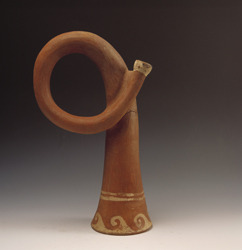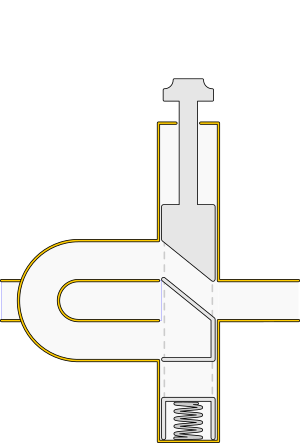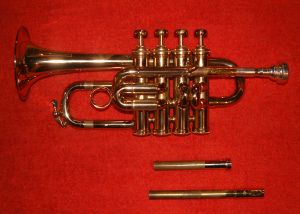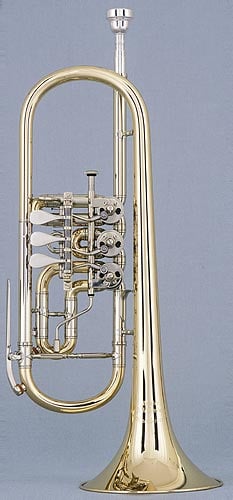Difference between revisions of "Trumpet" - New World Encyclopedia
(New page: {{redirect|Trumpeter}} {{Infobox Instrument |color1=#FFD700 |color2=#FFEC8B |name=Trumpet |image=Trumpet_1.jpg |classification= *Wind *Brass *[[...) |
|||
| Line 136: | Line 136: | ||
[[Category:art, music, literature, sports and leisure]] | [[Category:art, music, literature, sports and leisure]] | ||
[[Category:music]] | [[Category:music]] | ||
| + | [[Category:musical instruments]] | ||
{{credit|265789149}} | {{credit|265789149}} | ||
Revision as of 22:40, 17 June 2019
- "Trumpeter" redirects here.
| Trumpet | ||||||
|
The trumpet is a musical instrument with the highest register in the brass family. [1] Trumpets are among the oldest musical instruments,[2] dating back to at least 1500 B.C.E. They are constructed of brass tubing bent twice into an oblong shape, and are played by blowing air through closed lips, producing a "buzzing" sound which starts a standing wave vibration in the air column inside the trumpet.
There are several types of trumpet; the most common is a transposing instrument pitched in B♭. The predecessors to trumpets did not have valves; however, modern trumpets have either three piston valves or three rotary valves, each of which increases the length of tubing when engaged, thereby lowering the pitch.
The trumpet is used in many forms of music, including classical music and jazz.
History
The earliest trumpets date back to 1500 B.C.E. and earlier. The bronze and silver trumpets from Tutankhamun's grave in Egypt, bronze lurs from Scandinavia, and metal trumpets from China date back to this period.[3] Trumpets from the Oxus civilization (3rd millennium B.C.E.) of Central Asia have decorated swellings in the middle, yet are made out of one sheet of metal, which is considered a technical wonder.[4] The Moche people of ancient Peru depicted trumpets in their art going back to 300 C.E. [5] The earliest trumpets were signaling instruments used for military or religious purposes, rather than music in the modern sense;[6] and the modern bugle continues this signaling tradition.
In medieval times, trumpet playing was a guarded craft, its instruction occurring only within highly selective guilds. The trumpet players were often among the most heavily guarded members of a troop, as they were relied upon to relay instructions to other sections of the army. Improvements to instrument design and metal making in the late Middle Ages and Renaissance led to an increased usefulness of the trumpet as a musical instrument. The development of the upper, "clarino" register by specialist trumpeters - notably Cesare Bendinelli - would lend itself well to the Baroque era, also known as the "Golden Age of the natural trumpet."
The melody-dominated homophony of the classical and romantic periods relegated the trumpet to a secondary role by most major composers. Berlioz wrote in 1844:
"Notwithstanding the real loftiness and distinguished nature of its quality of tone, there are few instruments that have been more degraded (than the trumpet). Down to Beethoven and Weber, every composer - not excepting Mozart - persisted in confining it to the unworthy function of filling up, or in causing it to sound two or three commonplace rhythmical formulae."[7]
The trumpet was slow to adopt the modern valves (invented around the mid 1830s), and its cousin the cornet would take the spotlight as solo instrument for the next hundred years. Crooks and shanks (removable tubing of various lengths) as opposed to keys or valves were standard, notably in France, into the first part of the 20th century.
Construction
The trumpet is constructed of brass tubing bent twice into an oblong shape.[8] The trumpet and trombone share a roughly cylindrical bore which results in a bright, loud sound. The bore is actually a complex series of tapers, smaller at the mouthpiece receiver and larger just before the flare of the bell begins; careful design of these tapers is critical to the intonation of the instrument. By comparison, the cornet and flugelhorn have conical bores and produce a more mellow tone.
As with all brass instruments, sound is produced by blowing air through closed lips, producing a "buzzing" sound into the mouthpiece and starting a standing wave vibration in the air column inside the trumpet. The player can select the pitch from a range of overtones or harmonics by changing the lip aperture and tension (known as the embouchure). Modern trumpets also have three piston valves, each of which increases the length of tubing when engaged, thereby lowering the pitch. The first valve lowers the instrument's pitch by a whole step (2 semitones), the second valve by a half step (1 semitone), and the third valve by one-and-a-half steps (3 semitones). When a fourth valve is present, as with some piccolo trumpets, it lowers the pitch a perfect fourth (5 semitones). Used singly and in combination these valves make the instrument fully chromatic, i.e., able to play all twelve pitches of Western music. The sound is projected outward via the bell.
The trumpet's harmonic series is closely matched to the musical scale, but there are some notes in the series which are a compromise and thus slightly off key; these are known as wolf tones. Some trumpets have a slide mechanism built in to compensate.
The mouthpiece has a circular rim which provides a comfortable environment for the lips' vibration. Directly behind the rim is the cup, which channels the air into a much smaller opening (the back bore or shank) which tapers out slightly to match the diameter of the trumpet's lead pipe. The dimensions of these parts of the mouthpiece affect the timbre or quality of sound, the ease of playability, and player comfort. Generally, the wider and deeper the cup, the darker the sound and timbre.
Types of trumpets
The most common type is the B♭ trumpet, but C, D, E♭, E, F, G and A trumpets are also available. The most common use of the C trumpet is in American orchestral playing, where it is used alongside the B♭ trumpet. Its slightly smaller size gives it a brighter, more lively sound. Because music written for early trumpets required the use of a different trumpet for each key—they did not have valves and therefore were not chromatic—and also because a player may choose to play a particular passage on a different trumpet from the one indicated on the written music, orchestra trumpet players are generally adept at transposing music at sight, sometimes playing music written for the B♭ trumpet on the C trumpet, and vice versa.
Each trumpet's range extends from the written F♯ immediately below Middle C up to about three octaves higher. Standard repertoire rarely calls for notes beyond this range, and the fingering tables of most method books peak at the C (high C) two octaves above middle C. Several trumpeters have achieved fame for their proficiency in the extreme high register, among them Lew Soloff, Andrea Tofanelli, Bill Chase, Maynard Ferguson, Roger Ingram, Wayne Bergeron, Anthony Gorruso, Dizzy Gillespie, Jon Faddis, Cat Anderson, James Morrison, Doc Severinsen and Arturo Sandoval. It is also possible to produce pedal tones below the low F♯, although this technique is more often encountered as a sound-production exercise than as a written trumpet part.
The smallest trumpets are referred to as piccolo trumpets. The most common of these are built to play in both B♭ and A, with separate leadpipes for each key. The tubing in the B♭ piccolo trumpet is one-half the length of that in a standard B♭ trumpet. Piccolo trumpets in G, F and even C are also manufactured, but are rarer. Many players use a smaller mouthpiece on the piccolo trumpet, which requires a different sound production technique from the B♭ trumpet and can limit endurance. Almost all piccolo trumpets have four valves instead of the usual three—the fourth valve lowers the pitch, usually by a fourth, to facilitate the playing of lower notes. Maurice André, Håkan Hardenberger, and Wynton Marsalis are some well-known piccolo trumpet players.
Trumpets pitched in the key of G are also called sopranos, or soprano bugles, after their adaptation from military bugles. Traditionally used in drum and bugle corps, sopranos have featured both rotary valves and piston valves.
The bass trumpet is usually played by a trombone player, being at the same pitch. Bass trumpet is played with a trombone or euphonium mouthpiece, and music for it is written in treble clef.
The modern slide trumpet is a B♭ trumpet that has a slide instead of valves. It is similar to a soprano trombone. The first slide trumpets emerged during the Renaissance, predating the modern trombone, and are the first attempts to increase chromaticism on the instrument. Slide trumpets were the first trumpets allowed in the Christian church.[9]
The historical slide trumpet was probably first developed in the late fourteenth century for use in alta capella wind bands. Deriving from early straight trumpets, the Renaissance slide trumpet was essentially a natural trumpet with a sliding leadpipe. This single slide was rather awkward, as the entire corpus of the instrument moved, and the range of the slide was probably no more than a major third. Originals were probably pitched in D, to fit with shawms in D and G, probably at a typical pitch standard near A=466. As no instruments from this period are known to survive, the details - and even the existence - of a Renaissance slide trumpet is a matter of some conjecture, and there continues to be some debate among scholars.[10]
Some slide trumpet designs saw use in England in the eighteenth century.[11]
The pocket trumpet is a compact B♭ trumpet. The bell is usually smaller than a standard trumpet and the tubing is more tightly wound to reduce the instrument size without reducing the total tube length. Its design is not standardized, and the quality of various models varies greatly. It can have a tone quality and projection unique in the trumpet world: a warm sound and a voice-like articulation. Unfortunately, since many pocket trumpet models suffer from poor design as well as cheap and sloppy manufacturing, the intonation, tone color and dynamic range of such instruments are severely hindered. Professional-standard instruments are, however, available. While they are not a substitute for the full-sized instrument, they can be useful in certain contexts.
There are also rotary-valve, or German, trumpets, as well as alto and Baroque trumpets.
The trumpet is often confused with its close relative, the cornet, which has a more conical tubing shape compared to the trumpet's more cylindrical tube. This, along with additional bends in the cornet's tubing, gives the cornet a slightly mellower tone, but the instruments are otherwise nearly identical. They have the same length of tubing and, therefore, the same pitch, so music written for cornet and trumpet is interchangeable. Another relative, the flugelhorn, has tubing that is even more conical than that of the cornet, and an even richer tone. It is sometimes augmented with a fourth valve to improve the intonation of some lower notes.
Playing
Fingering
On any trumpet, cornet, or flugelhorn, pressing the valves indicated by the numbers below will produce the written notes shown - "OPEN" means all valves up, "1" means first valve, "1-2" means first and second valve simultaneously and so on. The concert pitch which sounds depends on the transposition of the instrument. Engaging the fourth valve, if present, drops any of these pitches by a perfect fourth as well. Within each overtone series, the different pitches are attained by changing the embouchure, or lip position and "firmness." Standard fingerings above high C are the same as for the notes an octave below (C♯ is 1-2, D is 1, etc.)
Note that the fundamental of each overtone series does not exist - the series begins with the first overtone. Notes in parentheses are the sixth overtone, representing a pitch with a frequency of seven times that of the fundamental; while this pitch is close to the note shown, it is slightly flat relative to equal temperament, and use of those fingerings is generally avoided.
The fingering schema arises from the length of each valve's tubing (a longer tube produces a lower pitch). Valve "1" increases the tubing length enough to lower the pitch by one whole step, valve "2" by one half step, and valve "3" by one and a half steps. This scheme and the nature of the overtone series create the possibility of alternate fingerings for certain notes. For example, third-space "C" can be produced with no valves engaged (standard fingering) or with valves 2-3. Also, any note produced with 1-2 as its standard fingering can also be produced with valve 3 - each drops the pitch by 1-1/2 steps. Alternate fingerings may be used to improve facility in certain passages. Extending the third valve slide when using the fingerings 1-3 or 1-2-3 further lowers the pitch slightly to improve intonation.
Instruction and method books
One trumpet method publication of long-standing popularity is Jean-Baptiste Arban's Complete Conservatory Method for Trumpet (Cornet).[12] Other well-known method books include "Technical Studies" by Herbert L. Clarke,[13] "Grand Method" by Louis Saint-Jacome, "Daily Drills and Technical Studies" by Max Schlossberg, and methods by Claude Gordon and Charles Colin.[14] Vassily Brandt's Orchestral Etudes and Last Etudes[15] is used in many college and conservatory trumpet studios, containing drills on permutations of standard orchestral trumpet repertoire, transpositions, and other advanced material. A common method book for beginners is the "Walter Beeler Method," and there have been several instruction books written by virtuoso Allen Vizzutti. The Breeze Eazy method is sometimes used to teach younger students, as it includes general musical information.
Players
The trumpet is used in many forms of music, though the most recognised players have been in the jazz field. Louis Armstrong, for example, was well known for his virtuosity with the trumpet. Armstrong's improvisations on his Hot Five and Hot Seven records were daring and sophisticated while also often subtle and melodic. Miles Davis is widely considered one of the most influential musicians of the 20th century. His trumpet playing was distinctive, with a vocal, clear tone that has been imitated by many. The phrasing and sense of space in his solos have been models for generations of jazz musicians.[16] Dizzy Gillespie was a trumpet virtuoso and gifted improviser, building on the style of Roy Eldridge but adding new layers of harmonic complexity. Gillespie had an enormous impact on virtually every subsequent trumpeter, both by the example of his playing and as a mentor to younger musicians. Maynard Ferguson came to prominence playing in Stan Kenton's orchestra, before forming his own band in 1957. He was noted for being able to play accurately in a remarkably high register.[17] While he was not the first trumpeter to play in the extreme upper register, he had a unique ability to play high notes with full, rich tone, power, and musicality. While regarded by some as showboating, Ferguson's tone, phrasing and vibrato was instantly recognizable and has been influential on and imitated by generations of amateur and professional trumpet players. A direct connection to Ferguson's style of playing continues in the work of the trumpeters who played with him, notably Roger Ingram, Wayne Bergeron, and Eric Miyashiro. Although some had believed that Ferguson was endowed with exceptional facial musculature, he often shared in interviews that his command of the upper registers was based mostly on breath control,[18] something he had discovered as a youngster in Montreal.
Among the other great modern jazz trumpet players are Clifford Brown, Jon Faddis, Harry James, Wynton Marsalis, Freddie Hubbard, Lee Morgan, Chet Baker, Arturo Sandoval, Doc Severinsen and Don Cherry.
Notable classical trumpeters include Maurice André, Roger Voisin, Armando Ghitalla, William Vacchiano, Adolph "Bud" Herseth, Charles Schlueter, Malcolm McNab, Sergei Nakariakov, Maurice Murphy, Hakan Hardenberger, Philip Smith, Rafael Méndez and Wynton Marsalis.
A musician who plays the trumpet is called a trumpet player or trumpeter.
Musical pieces
The trumpet is used in a wide range of musical styles including ska, ska punk, classical, jazz, Rock, Blues, pop, polka, cuban music, mariachi and funk.
Solos
The chromatic trumpet was first made in the late 1700s, but there were several solos written for the natural trumpet that are now played on piccolo trumpet; those old solos were of necessity high because the overtone series available to the natural trumpet only had stepwise notes at the top. Joseph Haydn's Trumpet Concerto was one of the first for a chromatic trumpet,[19] a fact shown off by some stepwise melodies played low in the instrument's range.
See also
- List of trumpeters
- Muted trumpet
- Piccolo trumpet
- Guča trumpet festival - The world's largest trumpet festival
Notes
- ↑ http://www.musicatschool.co.uk/year_7/Instruments_sheets/brass.PDF
- ↑ History of the Trumpet. www.petrouska.com. Retrieved 2008-05-03.
- ↑ Edward Tarr, The Trumpet (Portland, Oregon: Amadeus Press, 1988), 20-30.
- ↑ "Trumpet with a swelling decorated with a human head," Musée du Louvre, [1]
- ↑ Berrin, Katherine & Larco Museum. The Spirit of Ancient Peru:Treasures from the Museo Arqueológico Rafael Larco Herrera. New York: Thames and Hudson, 1997.
- ↑ Chicago Symphony Orchestra - Glossary - Brass instruments
- ↑ Berlioz, Hector (1844). Treatise on modern Instrumentation and Orchestration. Edwin F. Kalmus, NY, 1948.
- ↑ Trumpet, Brass Instrument
- ↑ Tarr
- ↑ IngentaConnect More about Renaissance slide trumpets: fact or fiction?
- ↑ [http://www.jstor.org/pss/899543 |title=JSTOR: Notes, Second Series, Vol. 54, No. 2, (1997 ), pp. 484-485.]
- ↑ Arban, Jean-Baptiste (1894, 1936, 1982). Arban's Complete Conservatory Method for TRUMPET. Carl Fischer, Inc. ISBN 0-8258-0385-3.
- ↑ Herbert L. Clarke (1984). Technical Studies for the Cornet,C. Carl Fischer, Inc. ISBN 0-8258-0158-3.
- ↑ Colin, Charles. Advanced Lip Flexibilities.
- ↑ Vassily Brandt Orchestral Etudes and Last Etudes. ISBN 0-7692-9779-X
- ↑ Miles Davis, Trumpeter, Dies; Jazz Genius, 65, Defined Cool
- ↑ Ferguson, Maynard. Encyclopedia of Music in Canada, The Canadian Encyclopedia.
- ↑ Zan Stewart. Maynard's Changes: September, Down Beat, 1985. "There's nothing superstrong about my lip, but there is about my range and stamina. That comes from [...] my breathing."
- ↑ Keith Anderson, liner notes for Naxos CD 8.550243, Famous Trumpet Concertos, "Haydn's concerto, written for Weidinger in 1796, must have startled contemporary audiences by its novelty. At the first performance of the new concerto in Vienna in 1800 a trumpet melody was heard in a lower register than had hitherto been practicable."
ReferencesISBN links support NWE through referral fees
- Don L. Smithers, The Music and History of the Baroque Trumpet Before 1721, Syracuse University Press, 1973, ISBN 0815621574
- Philip Bate, The Trumpet and Trombone: An Outline of Their History, Development, and Construction, Ernest Benn, 1978, ISBN 0393021297
- Roger Sherman, Trumpeter's Handbook: A Comprehensive Guide to Playing and Teaching the Trumpet, Accura Music, 1979, ISBN 0918194024
- Stan Skardinski, You Can't Be Timid With a Trumpet: Notes from the Orchestra, Lothrop, Lee & Shepard Books, 1980, ISBN 0688419631
- Robert Barclay, The Art of the Trumpet-Maker: The Materials, Tools and Techniques of the Seventeenth and Eighteenth Centuries in Nuremberg , Oxford University Press, 1992, ISBN 0198162235
- James Arthur Brownlow, The Last Trumpet: A History of the English Slide Trumpet, Pendragon Press, 1996, ISBN 0945193815
- Frank Gabriel Campos, Trumpet Technique, Oxford University Press, 2005, ISBN 0195166922
External links
- International Trumpet Guild international trumpet players' association with online library of scholarly journal back issues, news, jobs and other trumpet resources.
- Jay Lichtmann's trumpet studies Scales and technical trumpet studies.
- Dallas Music—a non-profit musical instrument resource site
 PDF
PDF
Credits
New World Encyclopedia writers and editors rewrote and completed the Wikipedia article in accordance with New World Encyclopedia standards. This article abides by terms of the Creative Commons CC-by-sa 3.0 License (CC-by-sa), which may be used and disseminated with proper attribution. Credit is due under the terms of this license that can reference both the New World Encyclopedia contributors and the selfless volunteer contributors of the Wikimedia Foundation. To cite this article click here for a list of acceptable citing formats.The history of earlier contributions by wikipedians is accessible to researchers here:
The history of this article since it was imported to New World Encyclopedia:
Note: Some restrictions may apply to use of individual images which are separately licensed.







